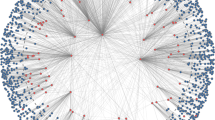Abstract
The problem of finding the size of the largest clique in an undirected graph isNP-hard, even to well-approximate, in the worst case. Simple algorithms,including some we study here, work quite well however, on graphs sampled fromu(n), the uniform distribution on n-vertex graphs. It is felt by many,however, that u(n) does not accurately reflect the nature ofinstances that come up in practice. It is argued that when the actualdistribution of instances is unknown, it is more appropriate to suppose thatinstances come from the Solomonoff–Levin or t universal distributionm(x) instead, which assigns higher weight to instances with shorterdescriptions (i.e., to those that are structured or compressible). We extend atheorem of Li and Vitanyi to show that the average-case performance ratio ofany approximation algorithm on random instances drawn from m(x) hasthe same asymptotic order as its worst-case performance ratio. Becausem(x) is neither computable nor samplable, we employ a realisticanalogue q(x) which lends itself to efficient empirical testing. Weexperimentally evaluate how well certain neural network algorithms for Maximum Clique perform on graphs drawn from q(x), as compared to those drawn from u(n). The experimental results are as follows. All nine algorithms we evaluated performed roughly equally-well on u(n), where as three of them — the simplest ones — performed markedly poorer than the other six on q(x). Our results suggest that q(x), while postulated as a more realistic distribution to test the performance of algorithms than u(n), also discriminates their performance better. Our q(x)sampler can be used to generate compressible instances of any discrete problem.
Similar content being viewed by others
References
S. Arora, C. Lund, R. Motwani, M. Sudan, and M. Szegedy. Proof verification and hardness of approximation problems. In The Proceedings of the 33rd Annual IEEE Symposium on Foundations of Computer Science, pages 14–23, 1992.
G. Bilbro, R. Mann, T.K. Miller, W.E. Snyder, D.E. Van den Bout, and M. White. Optimization by mean field annealing. In D.S. Touretzky, editor, Advances in Neural Information Processing Systems, volume 1, pages 91–98, San Mateo, 1989. (Denver 1988), Morgan Kaufmann.
R. Carraghan and P.M. Pardalos. An exact algorithm for the maximum clique problem. Operations Research Letters, 9: 375–382, 1990.
U. Feige, S. Goldwasser, L. Lovasz, S. Safra, and M. Szegedy. Approximating clique is almost np-complete. In The Proceedings of the 32nd Annual IEEE Symposium on Foundations of Computer Science, pages 2–12, 1991.
Y. Gurevich and S. Shelah. Nearly linear time. In Proceedings, Logic at Botik, Lecture Notes in Computer Science No. 363, pages 108–118. Springer-Verlag, 1989.
J. Hertz, A. Krogh, and R.G. Palmer. Introduction to the Theory of Neural Computation. Addison-Wesley, 1991.
J.J. Hopfield. Neural networks and physical systems with emergent collective computational abilities. Proceedings of the National Academy of Sciences, USA, 79, 1982.
J.J. Hopfield. Neurons with graded responses have collective computational properties like those of two-state neurons. Proceedings of the National Academy of Sciences, USA, 81, 1984.
A. Jagota, Approximating maximum clique in a Hopfield-style network. IEEE Transactions on Neural Networks 6(3): 724–735, 1995.
A. Jagota, L. Sanchis, and R. Ganesan. Approximating maximum clique using neural network and related heuristics. In D.S. Johnson and M. Trick, editors, DIMACS Series: Second DIMACS Implementation Challenge 26: 169–204. AMS, 1996.
R.M. Karp. The probabilistic analysis of some combinatorial search algorithms. In J.F. Traub, editor, Algorithms and Complexity: New Directions and Recent Results, pages 1–19. Academic Press, New York, 1976.
M. Li and P.M.B. Vitanyi. Kolmogorov complexity and its applications. In J. vanLeeuwen, editor, Handbook of Theoretical Computer Science, pages 187–254. Elsevier and MIT Press, Amsterdam/New York, 1990.
M. Li and P.M.B. Vitanyi. Average case complexity under the universal distribution equals worst-case complexity. Information Processing Letters 42: 145–149, May 1992.
P. Miltersen. The complexity of malign ensembles. In The Proceedings of the 6th Annual IEEE Conference on Structure in Complexity Theory, pages 164–171, 1991.
E.M. Palmer. Graphical Evolution. Wiley, New York, 1985. Matula’s theorem on page 76.
P.M. Pardalos and J. Xue. The maximum clique problem. Journal of Global Optimization 4: 301–328, 1994.
C. Peterson and B. Söderberg. A new method for mapping optimization problems onto neural networks. International Journal of Neural Systems 1: 3–22, 1989.
Author information
Authors and Affiliations
Rights and permissions
About this article
Cite this article
Jagota, A.K., Regan, K.W. Performance of Neural Net Heuristics for Maximum Clique on Diverse Highly Compressible Graphs. Journal of Global Optimization 10, 439–465 (1997). https://doi.org/10.1023/A:1008263614366
Issue Date:
DOI: https://doi.org/10.1023/A:1008263614366




